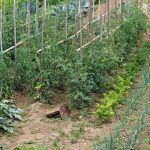In recent years, there has been a steady rise in vertical vegetable gardens, capturing the attention of urban dwellers and gardening enthusiasts alike. These innovative gardens offer a unique solution to the challenges posed by limited space and increasing urbanization. By utilizing vertical structures to grow vegetables, individuals can maximize their available space while still enjoying the benefits of homegrown produce.
The popularity of vertical vegetable gardens can be attributed to several factors. With more people living in urban areas and lacking traditional garden space, these gardens have become an appealing option for those who want to cultivate their own crops. Additionally, vertical gardens offer practical solutions for apartment dwellers or homeowners with small yards who desire fresh vegetables within arm’s reach.
Choosing the perfect spot for your vertical vegetable garden is essential to its success. By identifying locations with ample sunlight and minimal shade, you can ensure your plants receive the necessary light and warmth they need to thrive. Factors such as access to water and proximity to the kitchen should also be considered for easy maintenance and convenience.
As we delve deeper into the world of vertical vegetable gardening, it is important to understand which plants are best suited for these types of gardens. Some vegetables naturally excel in a vertical growing environment due to their climbing or vining nature. By selecting plants that are compatible with vertical structures, you can optimize your garden’s productivity.
With rising interest in sustainable living and self-sufficiency, it is no wonder that vertical vegetable gardening has sparked a revolution among gardeners worldwide. In the following sections, we will explore various aspects of creating a successful vertical vegetable garden – from design considerations and soil preparation techniques to troubleshooting common issues and harvesting bountiful crops. Whether you have ample outdoor space or just a small balcony, there is a perfect solution waiting for you within the world of vertical gardening.
So join us as we embark on this journey into understanding the rise of vertical vegetable gardens and discover how you can revolutionize your own urban landscape through this innovative gardening method.
Getting Started
When it comes to setting up a vertical vegetable garden, selecting the right spot is essential for the success of your plants. Here are some key factors to consider when choosing the perfect location:
- Sunlight: Most vegetables require at least 6-8 hours of direct sunlight per day to thrive. Ideally, choose a spot that receives ample sunlight throughout the day. Observe the area at different times to ensure there are no large shadows from nearby buildings or trees that could block sunlight.
- Access to Water: Vegetables need regular watering, so it’s important to have easy access to a water source near your vertical garden. Consider proximity to a hose or faucet, or if you’ll be relying on manual watering methods, ensure there’s easy access from your water storage containers.
- Proximity to the Kitchen: One of the benefits of having a vertical vegetable garden is easy access to fresh produce for cooking and meal preparation. To make harvesting more convenient, choose a spot close to your kitchen. This will save you time and effort when it comes to gathering ingredients for meals.
| Factor | Considerations |
|---|---|
| Sunlight | 6-8 hours of direct sunlight per day |
| Access to Water | Proximity to water source or storage containers |
| Proximity to Kitchen | Closer distance for harvesting convenience |
Remember, each garden is unique, so consider these factors when choosing the ideal location for your vertical vegetable garden based on your specific circumstances. Once you have identified the perfect spot, you can move on to selecting the right plants for your vertical garden.
Selecting the Right Plants for Your Vertical Vegetable Garden
When it comes to selecting plants for your vertical vegetable garden, it is important to choose vegetables that are well-suited to vertical growing. This means opting for crops that have a compact growth habit, vine-like tendencies, or the ability to be trellised. By selecting the right plants, you can maximize your vertical space and ensure a bountiful harvest.
Best Vegetables for Vertical Gardens
Not all vegetables are suitable for growing in a vertical garden. Some vegetables naturally lend themselves to vertical growth and thrive when supported by structures such as trellises or stakes. These include cucumbers, tomatoes, beans, peas, zucchini, and various types of squash. These plants have long vines or tend to grow upwards and can easily be trained vertically.
Tips for Choosing Plants Based on Vertical Growing Capabilities
When choosing plants for your vertical vegetable garden, consider their specific needs and requirements. Look for varieties that have been bred specifically for small spaces or container gardening. Dwarf varieties of popular vegetables such as tomatoes or peppers are often well-suited for vertical gardens due to their compact size.
Additionally, consider the weight of the mature plants. Some vegetables can become quite heavy when fully grown, which may put stress on the structure supporting them. Opting for lightweight crops like lettuce or herbs can help prevent any potential damage to your vertical garden.
It is also important to consider companion planting when selecting plants for your vertical garden. Certain plants have natural affinities for others and can benefit from being planted together. For example, planting basil near tomatoes can help improve tomato flavor and deter pests. Research different companion planting combinations to optimize the growth of your vertical vegetable garden.
By carefully selecting the right plants based on their growth capabilities and compatibility with each other, you can create a thriving and productive vertical vegetable garden that yields an abundance of fresh produce throughout the growing season.
Designing and Constructing Your Vertical Vegetable Garden
When it comes to designing and constructing your vertical vegetable garden, there are a variety of options to choose from. The structure you select will depend on factors such as available space, budget, and personal preference. It is important to consider the pros and cons of different types of vertical gardens before making your decision.
One popular option for vertical gardening is the wall-mounted planter. These planters can be easily attached to walls or fences, making them ideal for small spaces. They also provide good drainage and allow for easy access when it comes to watering and harvesting. However, it’s important to ensure that the structure you choose is sturdy enough to support the weight of the plants and soil.
Another option is the freestanding vertical garden. This type of structure usually consists of multiple tiers or shelves that can hold pots or containers. Freestanding gardens are great for larger spaces and can provide an attractive focal point in your garden. However, they may require additional support to prevent tipping over, especially if they are exposed to strong winds.
If you prefer a more DIY approach, you can consider building a trellis system for your vertical vegetable garden. Trellises provide a framework for plants to climb on, maximizing space utilization. They are particularly well-suited for vining plants such as tomatoes, cucumbers, and beans. Building a trellis system requires some basic carpentry skills but can be a rewarding project for those who enjoy hands-on work.
Regardless of the type of structure you choose, it is important to ensure that your vertical garden receives adequate sunlight and airflow. This will help promote healthy growth and prevent issues such as mold or mildew. Additionally, it’s recommended to use lightweight potting mix or specialized media designed for vertical gardens to ensure proper drainage.
To summarize, designing and constructing a vertical vegetable garden involves considering factors such as available space, budget, and personal preference. There are different types of structures to choose from, such as wall-mounted planters, freestanding gardens, and trellis systems. It is important to ensure that your chosen structure provides adequate sunlight and airflow for optimal plant growth.
Soil and Planting Techniques for Vertical Vegetable Gardens
When it comes to vertical vegetable gardens, the right soil and planting techniques are key to the success of your crops. Unlike traditional in-ground gardens, vertical gardens have unique requirements that must be carefully considered. In this section, we will discuss the importance of quality soil and proper drainage in vertical gardening, as well as provide tips and techniques to efficiently plant and maintain crops in vertical gardens.
Importance of Quality Soil
In vertical vegetable gardening, using high-quality soil is crucial for promoting healthy plant growth. The soil should be rich in organic matter and have good water retention capabilities to ensure that plants receive enough moisture without becoming oversaturated. One option is to use a premixed potting soil specifically formulated for container gardening. These soils are typically lightweight, well-draining, and nutrient-rich.
To maximize the benefits of quality soil, consider adding compost or organic matter such as peat moss or coconut coir to improve its nutrient content and water-holding capacity. Amending the soil with perlite or vermiculite can also help with drainage while retaining some moisture.
Proper Drainage
With vertical gardens, proper drainage is essential to prevent waterlogged roots which can lead to root rot and other plant diseases. Most vertical garden structures come with built-in drainage systems; however, it’s important to monitor them regularly to ensure they are functioning properly. Avoid overwatering your plants by checking the moisture level of the soil before watering again.
One effective technique for improving drainage is incorporating a layer of gravel or small stones at the bottom of your plant containers or pockets. This layer allows excess water to flow away from the root zone, preventing it from sitting stagnant in the soil.
Planting Techniques
In vertical vegetable gardening, selecting appropriate planting techniques can optimize space usage and promote healthier growth for your crops. Here are a few techniques to consider:
- Staggered Planting: Plant crops at staggered intervals to ensure continuous harvest throughout the growing season. This allows you to maximize the vertical space and avoid overcrowding.
- Companion Planting: Create mutually beneficial plant combinations where one plant helps enhance the growth or ward off pests of another. For example, planting marigolds next to tomatoes can deter insects and suppress weeds.
- Trellising: Utilize trellises, stakes, or cages to support climbing plants such as beans, cucumbers, and peas. This promotes better air circulation and reduces the risk of disease.
- Intensive Planting: Take advantage of vertical space by densely planting crops in close proximity. However, be mindful not to overcrowd your plants as this can lead to competition for resources and increased susceptibility to disease.
By applying these soil and planting techniques in your vertical vegetable garden, you’ll be on your way to creating a thriving and productive garden that makes the most of limited space while minimizing maintenance efforts.
Vertical Vegetable Gardening Tips and Tricks for Optimal Growth
Vertical gardening has gained popularity in recent years due to its space-saving nature and ability to maximize yields in small areas. To ensure optimal growth and productivity in your vertical vegetable garden, there are several tips and tricks you can follow.
Watering
- Regular watering is essential for the success of your vertical garden. Check the moisture level of the soil frequently and water as needed.
- Consider installing a drip irrigation system or using a soaker hose to provide consistent moisture to your plants.
- Avoid overwatering, as it can lead to root rot and other fungal diseases. Allow the soil to dry slightly between watering sessions.
Fertilizing
- Choose a well-balanced, slow-release fertilizer that provides essential nutrients for your plants’ growth.
- Apply fertilizers according to package instructions and avoid over-fertilization, as excessive nutrients can harm plants.
- Consider using organic fertilizers such as compost or compost tea to improve soil fertility in a natural and sustainable way.
Mulching
- Applying a layer of mulch around your plants helps retain moisture, suppresses weed growth, and regulates soil temperature.
- Select organic mulches like straw, wood chips, or shredded leaves for better nutrient cycling and improved soil health.
- Avoid placing mulch too close to plant stems to prevent potential pest problems or stem rot.
Companion Planting
- Take advantage of companion planting techniques by pairing compatible plant species together in your vertical garden.
- Select plants that have mutually beneficial relationships, such as marigolds with tomatoes (to deter pests) or beans with corn (to provide natural trellising support).
- Companion planting can help maximize space, improve pest control, and enhance pollination in your vertical garden.
Trellising
- To optimize space utilization, consider using trellises or cages to support vining or climbing plants.
- Install sturdy trellis structures and train your plants to climb them as they grow. This promotes better airflow, reduces the chances of disease, and makes harvesting easier.
- Choose appropriate plant varieties that are well-suited for vertical growth and have a natural inclination to climb or vine.
By following these tips and tricks, you can ensure optimal growth and productivity in your vertical vegetable garden. These practices not only help you utilize limited space efficiently but also contribute to sustainable food production and a healthier environment.
Troubleshooting Common Issues in Vertical Vegetable Gardens
Vertical vegetable gardening offers a unique way to grow a bountiful harvest in limited spaces. However, like any type of gardening, it is not without its challenges. In this section, we will discuss common issues that may arise in vertical vegetable gardens and provide solutions to help you overcome them.
One of the most common problems faced by vertical gardeners is pests and diseases. Vertical gardens are not immune to these issues, and it is important to be proactive in preventing and addressing them. Common pests such as aphids, mealybugs, and spider mites can be controlled with organic pest control methods such as insecticidal soap or neem oil. Regular inspections of your plants can help catch any infestations early on before they have a chance to spread.
Diseases such as powdery mildew and blight are also concerns for vertical gardeners. To prevent the spread of diseases, ensure that your plants have adequate spacing between them to promote airflow. Remove any infected leaves or plants immediately to prevent further contamination. Additionally, it is crucial to practice good hygiene by cleaning your tools between uses and avoiding overhead watering that can contribute to disease development.
Another challenge that vertical gardeners may face is inadequate pollination. Some vegetables require the assistance of pollinators like bees to produce fruit properly. In an enclosed vertical garden environment, attracting pollinators might prove difficult. To encourage pollination, consider planting flowering companion plants nearby or hand-pollinate your vegetable flowers using a small brush or cotton swab.
Overcrowding is another issue that can negatively impact the growth and productivity of your plants in a vertical garden. It is essential to follow recommended spacing guidelines for each plant variety to ensure proper airflow and ample sunlight penetration. Regularly thinning out overcrowded areas will allow the remaining plants to flourish and reduce competition for resources.
By understanding these common issues in vertical vegetable gardens and implementing the solutions provided, you can overcome challenges and enjoy a successful harvest. Remember that each garden is unique, and it may require some trial-and-error to find the best strategies for your specific circumstances. With perseverance and a little troubleshooting, your vertical garden will thrive, providing you with an abundance of homegrown veggies.
Harvesting and Enjoying the Fruits (and Vegetables) of Your Labor
After weeks or even months of care and attention, it is finally time to reap the rewards of your vertical vegetable garden. Harvesting your homegrown produce not only allows you to enjoy the fruits (and vegetables) of your labor but also encourages a deeper connection with nature and a greater appreciation for sustainable living.
In this section, we will guide you on when and how to harvest your vegetables, as well as inspire creative recipes and ways to utilize your homegrown produce in the kitchen.
Knowing when to harvest your vegetables is crucial to ensure their optimal flavor and nutrient content. While each plant has specific harvesting requirements, there are general guidelines that can help you determine the right time. For leafy greens such as lettuce or spinach, they are usually ready for harvest once they reach a size that you desire. Harvest these varieties by cutting off the leaves at their base, leaving a few inches intact so they can regrow.
For fruits such as tomatoes or cucumbers, wait until they have fully matured before picking them. This means waiting until they reach their ideal color and have a firm texture. Gently twist or cut them from the vine using pruning shears or a sharp knife. On the other hand, root vegetables like carrots or radishes should be harvested when the tops start to poke out above the soil line.
Once you have harvested your crops, it’s time to put them to good use in the kitchen. The freshness and quality of homegrown produce often enhance flavors which can elevate any dish. Consider incorporating your vegetables into simple salads or stir-fries where their vibrant colors and crisp textures shine through. You can also pickle surplus cucumbers or roast excess root vegetables for longer shelf life.
Not only do vertical gardens provide fresh produce, but they also enable creative opportunities for cooking enthusiasts who want to explore new flavors and experiment with fresh ingredients. By harvesting and utilizing the fruits (and vegetables) of your labor, you can truly appreciate the satisfaction of growing your own food and embracing a sustainable lifestyle.
In the next section, we will showcase real-life examples and success stories of individuals and communities who have embraced vertical gardening. These stories will not only inspire you but also provide valuable insights into different vertical garden designs and their impact on urban landscapes. Let’s explore the transformative potential of vertical vegetable gardens together.
Showcasing Vertical Vegetable Gardens
Vertical vegetable gardens have become increasingly popular in recent years, as more and more people embrace the idea of growing their own food in limited spaces. Across the world, individuals and communities have found creative ways to incorporate vertical gardening into their urban landscapes, resulting in innovative and inspiring designs. In this section, we will showcase some real-life examples and success stories of vertical vegetable gardens that have made a significant impact.
One such success story is the Bosco Verticale in Milan, Italy. Designed by architect Stefano Boeri, this residential building features over 900 trees and 2,000 plants on its balconies, creating a vertical forest in the heart of the city.
Not only does it provide residents with fresh air and a connection to nature, but it also helps purify the surrounding environment. The Bosco Verticale is an excellent example of how vertical gardening can transform urban spaces into sustainable and green living environments.
Another inspiring example is found in Singapore’s City Greenery program. As an effort to increase green spaces in the city-state, Singapore has implemented vertical gardens on multiple buildings, including schools and public housing estates. These vertical gardens not only beautify the concrete landscape but also serve as learning opportunities for students and communities. By showcasing innovative designs and sustainable practices, these projects inspire others to consider implementing vertical vegetable gardens within their own surroundings.
These are just two examples among many showcasing the potential of vertical vegetable gardens to revolutionize urban landscapes. Through these real-life examples and success stories, it becomes clear that designing and implementing vertical gardens can have a profound impact on environmental sustainability, food production, and community well-being. By integrating plants vertically into our built environments, we can make cities greener and healthier places to live while positively contributing towards food security for future generations.
Conclusion
In conclusion, vertical vegetable gardens have emerged as a revolutionary solution for urban dwellers and gardening enthusiasts alike. With the increasing urbanization and limited space concerns in our modern world, vertical gardens offer a practical and innovative way to grow fresh produce right at home. As we have explored throughout this article, the popularity of vertical vegetable gardens has been steadily rising due to their numerous benefits.
One of the key advantages of vertical gardening is its ability to maximize limited space. By utilizing walls, fences, or even balcony railings, individuals can transform unused areas into flourishing gardens. This not only allows for efficient use of space but also provides an opportunity for city-dwellers to cultivate their own food and connect with nature.
Furthermore, vertical vegetable gardens offer a sustainable solution towards food production. By growing food vertically, we can minimize the need for large plots of land, excessive water usage, and transportation costs associated with commercial farming. This puts control over our food sources back into our own hands and contributes to a more sustainable future.
Frequently Asked Questions
What vegetables can you grow in a vertical garden?
In a vertical garden, you can grow a wide variety of vegetables. Some popular choices include lettuce, spinach, kale, Swiss chard, herbs like basil and parsley, tomatoes (if supported with stakes or cages), cucumbers (if provided with trellis or support), bell peppers, beans (such as pole beans), and even some types of small root vegetables like radishes and carrots.
The key is to choose compact or dwarf varieties that don’t require extensive space for their growth.
How do you start a vertical vegetable garden?
Starting a vertical vegetable garden requires careful planning and preparation. First, select a suitable location that gets adequate sunlight for the chosen vegetables to thrive. Install a sturdy trellis, fence, or hanging system that can support the weight of the plants when fully grown.
Ensure proper soil drainage by adding compost or organic matter to improve the quality and structure of the soil. Select vegetable varieties based on the available sunlight and growing conditions in your area. Plant seedlings or seeds according to the instructions provided for each vegetable type, ensuring proper spacing between plants to prevent overcrowding.
Are there any drawbacks to using vertical gardens?
While there are numerous benefits to using vertical gardens, there are also some drawbacks worth considering. One drawback is the limited space available for each plant in a vertical arrangement compared to traditional gardens. This means you might not be able to grow as many plants overall or harvest as large a yield from each plant.
Another potential drawback is that vertical gardens may require more frequent watering due to increased exposure to wind and sun, especially if they are made of materials that encourage faster evaporation of moisture from the soil. Finally, if not properly maintained, vertical gardens can become heavy due to water retention and put stress on supporting structures over time if not designed and installed correctly.

If you’re looking to get into vegetable gardening, or are just looking for some tips on how to make your current garden better, then you’ve come to the right place! My name is Ethel and I have been gardening for years. In this blog, I’m going to share with you some of my best tips on how to create a successful vegetable garden.





